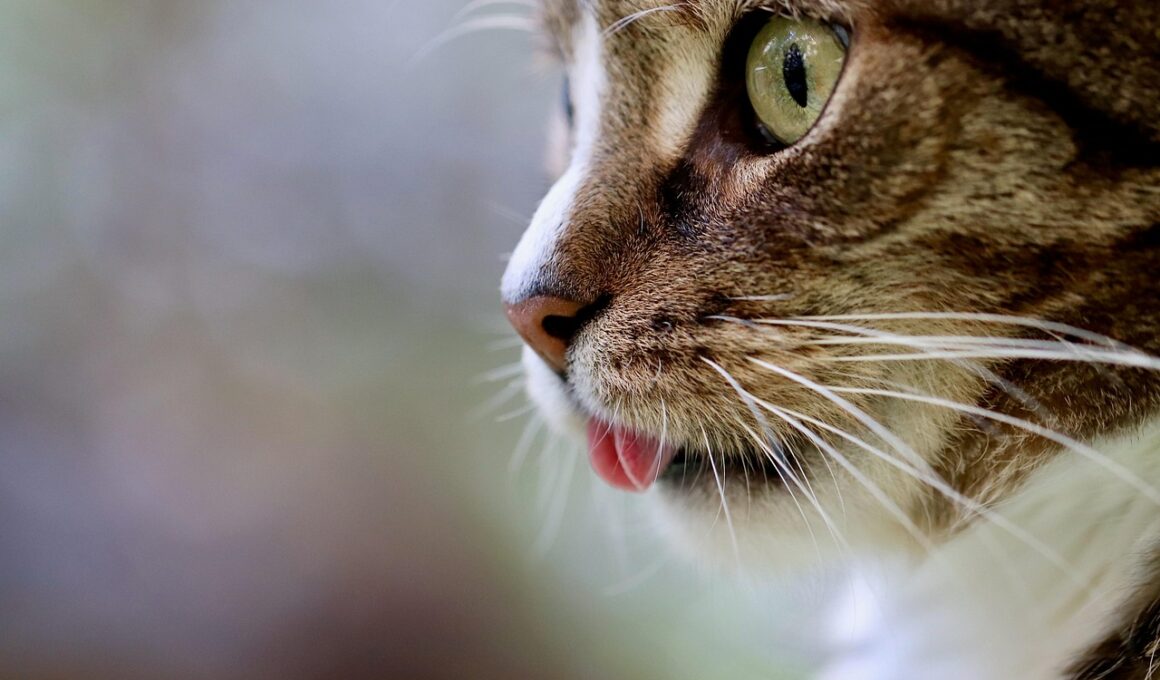Allergy-Proof Bedding and Living Spaces for Senior Cats
Creating an optimal living environment for senior cats with allergies requires thoughtful considerations regarding bedding and space management. It’s essential that your cat feels comfortable in their home, so switching to hypoallergenic materials can be beneficial. Bedding made from materials such as organic cotton, bamboo, or microfiber can significantly minimize allergic reactions. These materials are less likely to trap dust mites or allergens common in traditional fabrics. Furthermore, frequent washing of your cat’s bedding in hot water can help eliminate potential allergens. Also consider utilizing allergen-proof covers for pillows and mattresses, creating layers of protection against irritants. Elevating your cat’s sleeping area may improve airflow and limit exposure to dust on the ground. Make sure to vacuum and dust regularly to maintain a clean environment. Remove clutter to reduce hiding spots for dust. Place cat beds in low-traffic areas to provide a peaceful sanctuary. Pay attention to your cat’s behavior; any signs of discomfort may indicate the need for further adjustments. Regular vet visits can also help in managing allergy-related issues effectively.
Another crucial aspect of managing a senior cat’s allergies is the selection of appropriate furniture. Opt for surfaces that are easy to clean and less likely to hold allergens, such as leather or treated wood. Avoid upholstered furniture, as it can trap fur and dust which might exacerbate allergic reactions. Choose furniture that doesn’t have small crevices where allergens can accumulate. Regularly wipe down any furniture with a damp cloth to trap dust and dander before it becomes airborne. Additionally, consider incorporating washable throws or slipcovers that can be laundered often, maintaining a fresh environment. Dotting the living space with cat-friendly plants that are also non-toxic can enhance your cat’s wellbeing while creating a soothing atmosphere. Limiting the use of carpets and heavy drapes can prevent allergens from settling in. For enhanced comfort, create designated cat-friendly zones using mats or washable rugs. Make sure to keep these areas free from dust and hair build-up. If your cat has designated spots, it will be easier for you to manage their environment and keep it clean. Always stay attuned to your cat’s needs, adjusting their spaces as necessary for optimal health.
Air Filtration and Ventilation
Excellent air quality is vital when creating allergy-proof spaces for senior cats. Investing in high-efficiency particulate air (HEPA) filters can dramatically improve indoor air quality. HEPA filters trap allergens such as dust, pollen, and pet dander, making them essential in environments where allergies are a concern. Place these air filters in areas where your cat spends a lot of time, ensuring that air circulation is optimal. Additionally, ensure proper ventilation in your home by opening windows regularly, allowing fresh air to circulate. This helps to reduce stale air burdened with allergens. It’s also advantageous to limit the use of chemical air fresheners or sprays, as they can introduce more irritants into your cat’s environment. Instead, opt for natural alternatives like essential oil diffusers with scents that are pet-safe. Clean the air vents and ducts at least once a year to prevent dust accumulation. You might also consider using an air purifier for continuous allergen management. Regular monitoring of humidity levels is equally important; too much moisture can encourage mold growth, so aim for a balanced humidity range to benefit your cat’s health.
In addition to air quality, maintaining a clean litter box area is crucial for minimizing allergy triggers for senior cats. It’s important to select a hypoallergenic litter that is low in dust, as traditional litters can release fine particles that may irritate. Brands made from natural materials such as corn, wheat, or recycled paper offer great alternatives. Ensure to clean the litter box daily, disposing of waste promptly to avoid lingering odors and allergens. Using a covered litter box may help contain odors and mess but make sure it has sufficient ventilation. However, watch for your cat’s preferences as not all cats will adapt well to covered boxes. If your senior cat has mobility issues, opt for litter boxes with lower sides for easier access. Regularly changing the litter and thoroughly cleaning the box every week helps to prevent buildup. Additionally, consider placing the litter box in a quiet, low-traffic area to reduce stress for your cat. Always monitor their reactions; any change in behavior regarding the litter box may signal discomfort with their environment. Keeping your cat’s bathroom space clean is essential for their health.
The Importance of Grooming
No allergy management plan is complete without addressing grooming to keep dander and loose hair in check. Regular grooming helps reduce allergens in your home significantly. Use hypoallergenic cat shampoos during bath time that are formulated specifically for sensitive skin. In addition to baths, brushing your senior cat on a regular schedule can remove loose fur and skin flakes. Brushing helps in distributing natural oils across their coat, promoting skin and fur health. Depending on your cat’s coat type, choose suitable grooming tools such as slicker brushes or combs to avoid skin irritation. Set a grooming routine that is relaxing for your cat, providing treats and praise to create a positive association. Pay attention to your cat’s specific needs, especially if they have arthritis or other health issues that may hinder their ability to groom effectively. Reducing allergens through proactive grooming can significantly enhance your cat’s quality of life. Regular grooming not only keeps allergens at bay but also creates bonding moments between you and your cat, further improving their emotional wellbeing. Thus, make grooming a delightful and routine part of caring.
Behavior management is also an integral aspect of creating allergy-proof spaces for senior cats. Understanding your cat’s behavior helps in recognizing signs of discomfort related to allergies. Changes in grooming habits, increased scratching, or signs of stress may indicate allergic reactions. When you notice these symptoms, it’s essential to assess their living environment for possible allergens. Evaluating toys, litter, and bedding materials regularly can help pinpoint triggers. Introducing a designated area for your cat that features all their favorite items can alleviate anxiety. Encourage positive behavior by rewarding your cat for using designated areas. If you find that particular toys or items trigger allergies, consider replacing them with non-allergenic alternatives. Also, avoid scented products in their areas, as pets are sensitive to strong scents. Staff your home with pet-safe furniture that minimizes stress and allergies. Rearranging spaces can also create a fresh environment that may be calming for your cat. Always provide engaging activities, allowing your senior cat to play and explore without triggers. The key is observation and continuous adaptation of their environment based on their responses to ensure their comfort.
Conclusion
Implementing these strategies for creating allergy-proof spaces for senior cats can significantly enhance their quality of life. Prioritizing hypoallergenic materials for bedding and furniture helps minimize allergic reactions. Regular cleaning, grooming, and maintaining optimal air quality are equally important. Create a calm living environment that accommodates all your senior cat’s needs while ensuring their health and comfort. Stay informed about the latest allergy management techniques and discuss them with your veterinarian. Monitoring your cat’s behavior can provide valuable insights into their comfort levels, allowing you to make necessary adjustments promptly. Ultimately, improving their environment enhances your cat’s happiness and wellbeing. Take the time to personalize their space, providing plenty of love and attention to promote a harmonious household. A well-managed space allows your senior cat to thrive despite allergies, leading to a healthier and happier life overall. Invest in proper resources, stay diligent with cleaning, and always prioritize your pet’s needs. With thoughtful adjustments, you can create a healthy atmosphere where your senior cat feels safe, comfortable, and loved.


